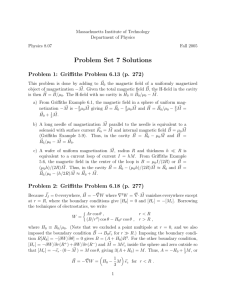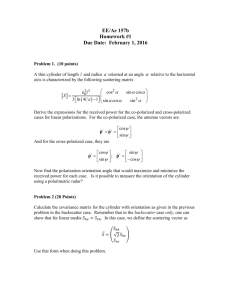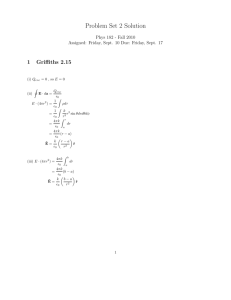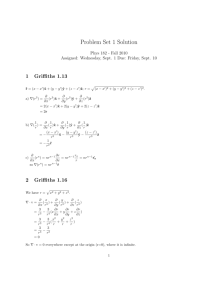Solutions - Duke Physics
advertisement
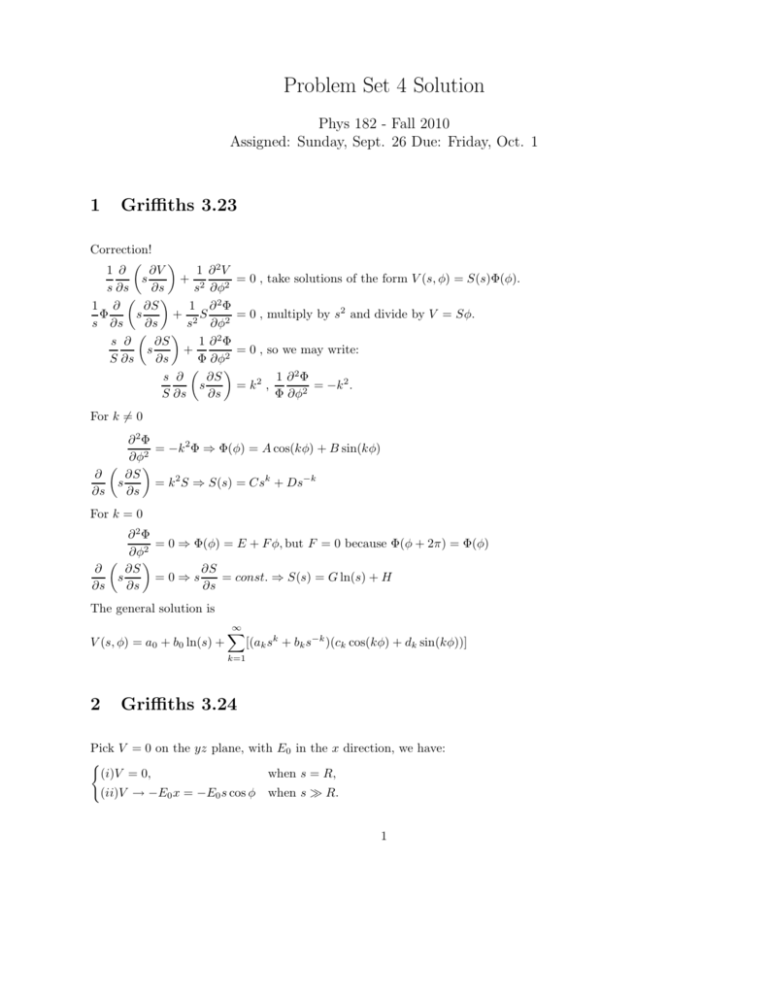
Problem Set 4 Solution Phys 182 - Fall 2010 Assigned: Sunday, Sept. 26 Due: Friday, Oct. 1 1 Griffiths 3.23 Correction! ∂V 1 ∂ 2V 1 ∂ s + 2 = 0 , take solutions of the form V (s, φ) = S(s)Φ(φ). s ∂s ∂s s ∂φ2 1 ∂ ∂S 1 ∂2Φ s + 2 S 2 = 0 , multiply by s2 and divide by V = Sφ. Φ s ∂s ∂s s ∂φ s ∂ ∂S 1 ∂2Φ s + = 0 , so we may write: S ∂s ∂s Φ ∂φ2 ∂S 1 ∂2Φ s ∂ s = k2 , = −k 2 . S ∂s ∂s Φ ∂φ2 For k 6= 0 ∂2Φ = −k 2 Φ ⇒ Φ(φ) = A cos(kφ) + B sin(kφ) ∂φ2 ∂ ∂S s = k 2 S ⇒ S(s) = Csk + Ds−k ∂s ∂s For k = 0 ∂2Φ = 0 ⇒ Φ(φ) = E + F φ, but F = 0 because Φ(φ + 2π) = Φ(φ) ∂φ2 ∂ ∂S ∂S s =0⇒s = const. ⇒ S(s) = G ln(s) + H ∂s ∂s ∂s The general solution is V (s, φ) = a0 + b0 ln(s) + ∞ X [(ak sk + bk s−k )(ck cos(kφ) + dk sin(kφ))] k=1 2 Griffiths 3.24 Pick V = 0 on the yz plane, with E0 in the x direction, we have: ( (i)V = 0, when s = R, (ii)V → −E0 x = −E0 s cos φ when s ≫ R. 1 So a0 = b0 = bk = dk = 0, and ak = ck = 0 except for k = 1. c1 cos φ V (s, φ) = a1 s + s ( (i) ⇒ c1 = −a1 R2 (ii) ⇒ a1 = −E0 Therefore # " 2 E0 R2 R V (s, φ) = −E0 s + − 1 cos φ cos φ = −E0 s s s ∂V R2 σ = −ǫ0 = 2ǫ0 E0 cos φ = −ǫ0 E0 − 2 − 1 cos φ ∂s s=R s s=R 3 Griffiths 3.33 p = (p · r̂)r̂ + (p · θ̂)θ̂ = p cos(θ)r̂ − p sin(θ)θ̂. So 3(p · r̂)r̂ − p = 3p cos(θ)r̂ − p cos(θ)r̂ + p sin(θ)θ̂ = 2p cos(θ)r̂ + p sin(θ)θ̂ 4 Griffiths 4.1 E = V /x = 500/10−3 = 5 × 105 . From Table 4.1 α/4πǫ0 = 0.66 × 10−33 , so α = 7.34 × 10−41 . d p = αE = ed ⇒ d = αE/e = 2.29 × 10−16 m. = 4.6 × 10−6 . R To ionize, let d = R. Then R = αE/e = αV /ex ⇒ V = Rex/α = 108 V. 5 Griffiths 4.4 1 q αq r̂. Induced dipole moment of atom: p = αE = r̂. 2 4πǫ0 r2 4πǫ 0r 2αq 1 1 (to the right). Field of this dipole, at the location of q: E = 4πǫ0 r3 4πǫ0 r2 2 q 1 Force on q due to this field: F = 2α r 5 (attractive). 4πǫ0 Field of q: 2 6 Griffiths 4.7 If the potential is zero at infinity, the energy of a point charge Q is W = QV (r). For a physical dipole, with −q at r and +q at r + d, # " Z r+d E · dl . U = qV (r + d) − qV (r) = q − r For an ideal dipole the integral reduces to E · d U = −qE · d = −p · E, since p = qd. If you do not (or cannot) use infinity as the reference point, the result still holds as long as you bring the two charges in from the same point. 7 Griffiths 4.8 U = −p1 · E2 , but E2 = 8 1 1 1 1 [3(p2 · r̂)r̂ − p2 ]. So U = [p1 · p2 − 3(p1 · r̂)(p2 · r̂)]. 4πǫ0 r3 4πǫ0 r3 Griffiths 4.10 (a) σb = P · n̂ = kR, ρb = −∇ · P = − (b) For r < R, E = 1 ∂ 2 1 (r kr) = − 2 3kr2 = −3k. 2 r ∂r r 1 ρrr̂, so E = −(k/ǫ0 )r. 3ǫ0 4 For r > R, same as if all charge at center, but Qtot = (kR)(4πR2 ) + (−3k)( πR3 ) = 0, so E = 0. 3 9 Griffiths 4.13 Think of it as two cylinders of opposite uniform charge density ±ρ. Inside, the field at a distance s from the axis of a uniformly charged cylinder is given by Gauss’s Law: E2πsl = ǫ10 ρπs2 l ⇒ E = (ρ/2ǫ0 )s. For two such cylinders, one positively charged and the other negatively charged, the net field inside is E = E+ + E− = (ρ/2ǫ0 )(s+ − s− ). But S+ − s− = −d, so E = −ρd/(2ǫ0 ), where d is the vector from the negative axis to the positive axis. In this case the total dipole moment of a chunk of length l is P(πa2 l) = (ρπa2 l)d. So ρd = P, and E = −P/(2ǫ0 ) for s < a. Outside, Gauss’s law gives E2πsl = 1 2 ǫ0 ρπa l ⇒ E = 3 ρa2 ŝ 2ǫ0 s , for one cylinder. For the combination, E = E+ + E− = ŝ+ s+ ρa2 2ǫ0 ŝ+ s+ − ŝ− s− , where d s± = s ∓ 2 −1 −1 d2 s·d s·d d d s± d 1 1 2 ∼ ∼ s + 1∓ 2 1± 2 = s∓ ∓s·d = 2 s∓ = 2 s∓ s2± 2 4 s 2 s s 2 s (s · d) d 1 (keeping only 1st order terms in d). = 2 s±s 2 ∓ s s 2 (s · d) s 1 (s · d) d s(s · d) 1 ŝ− − s−s 2 + = 2 2 s+s 2 − = 2 − −d . s− s s 2 s 2 s s2 E(s) = 10 a2 1 [2(P · ŝ)ŝ − P], for s > a. 2ǫ0 s2 Griffiths 4.15 1 ∂ (a) ρb = −∇ · P = − 2 r ∂r Gauss’s law ⇒ E = ( +P · r̂ = k/b r=b k 2k r = − 2 . σb = P · n̂ = r r −P · r̂ = −k/a r = a 1 Qenc 4πǫ0 r 2 r̂. For r < a, Qenc = 0,so E = 0. For r > b, Qenc = 0,so E = 0. Rr ′2 ′ For a < r < b, Qenc = −k (4πa2 ) + a −k a r 2 4πr dr = −4πka − 4πk(r − a) = −4πkr, so E = −(k/ǫ0 r)r̂. I (b) D · da = Qfenc = 0 ⇒ D = 0 everywhere. D = ǫ0 E + P = 0 ⇒ E = (−1/ǫ0 )P, so E = 0 (for r < a and r > b); E = −(k/ǫ0 r)r̂ (for a < r < b). 4
